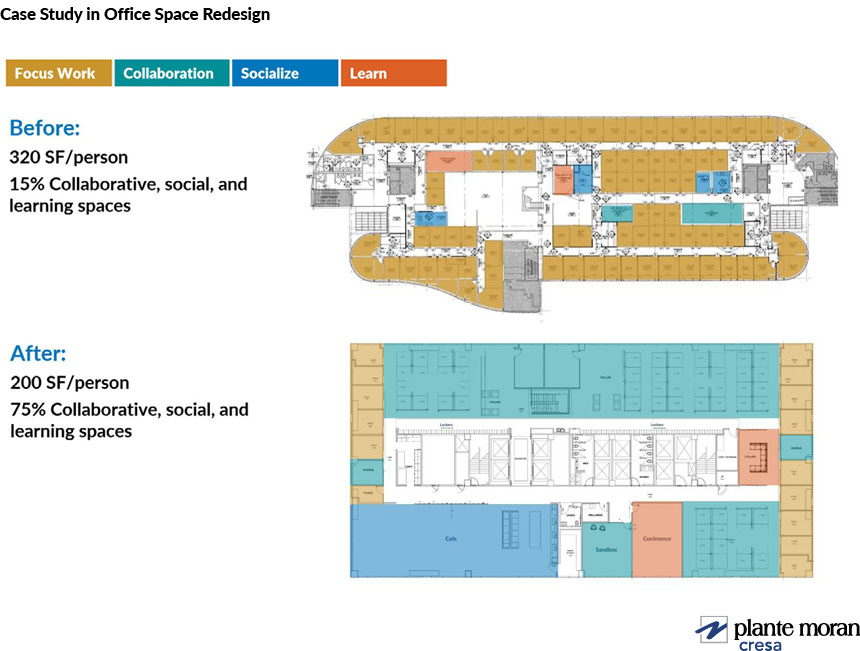For the last decade, users of office space, taking cues from Silicon Valley, were looking to modernize by knocking down the cubical wall and the window office in favor of more open, flexible, and vibrant workspace.
This strategy not only helped to attract and retain a new generation of mobile, tech-savvy workers, but also supported the four known working styles: focused, collaborative, social, and learning. The benefits of a modern workspace also included a potential decrease in square footage, the savings from which could be reinvested into higher-end buildouts or relocation to a better building with more amenities in a more urban, walkable location.
Then the pandemic changed everything, and the great “work from home experiment” began. Some workers were more productive than ever, while others more distracted, unproductive, and longing for more human interaction. Now, as the pandemic appears to be waning, the question of whether to return to the office is underway, and everyone is treading carefully.
One thing is clear: COVID-19 has not canceled the office. Stan Hannah, a partner at Plante Moran, references studies in his FORTUNE article, “You’ll never build a personal brand — unless you stop hiding behind remote work,” that show productivity has not increased with remote work and highlights its challenges. As Stan mentions, “Some of the most important learning in offices takes place after meetings, in the corridor, or by the coffee machine, as participants discuss what they learned and exchange experiences. On remote calls, that opportunity is lost at the click of the ‘End Meeting’ button.”
As pre-pandemic office leases look to expire, there are three workplace options facing organizations today: fully in office, fully remote, or hybrid. No one option will fit all organizations. Leaders need to have thoughtful discussions surrounding which strategy fits both their business plan and culture while laying out the pros and cons of how they will use office space and remote work in the future. The strategy may even vary within the organization, by the staff role and type of work.
In their Harvard Business Review (HBR) article, “What Professional Service Firms Must Do to Thrive,” authors Ashish Nanda and Das Nararandas reference the spectrum of professional services that includes commodity, procedure, gray hair, and rocket scientist. These categories can be useful in considering the workspace needs from the lens of a worker’s role. In a spectrum of work that includes solving routine simple problems to addressing unique and difficult problems, an argument could be made that some roles are more suited for remote work. Think of data entry, customer service, and call centers, where consistent technology and processes can be utilized at any location with very trackable metrics. At the other end of the spectrum is the highly sought-after “rocket scientist” roles, where the ROI is so high to the organization and the talent so rare that the work will go to them, rendering location less of a success factor.
Between these bookends exists roles where strong relationships are the key to successful outcomes, such as when knowledge is passed down from experienced staff to developing staff (apprenticeship model) or when knowledge recombination yields new products and services. Historically, individuals have helped both their organizations and careers flourish by impromptu relationships and dialogues, which can prove more challenging in a remote environment.
An organization’s workplace strategy should take into account all the types of work needed to drive productivity and staff growth. Use of the following matrix as a guide can be helpful when mapping out a work strategy.

If your organization decides a hybrid or fully back-to-the-office model is the best choice, how can you encourage workers to come back? By making workspace a destination with three elements:
- Flexibility. Change is the new constant. The workplace must continue to support the different ways people work.
- Compelling: The modern workforce is demanding that the in-office experience be as inviting as possible. Office spaces should be seamlessly integrated into the everyday lives of employees, providing necessities and amenities.
- Caring: The next generation of sustainability and caring for staff is about fitness as a lifestyle, the sustainable food movement, mental rejuvenation, and increasing performance through natural means. The need for human connection and interaction is necessary for the mental health of workers — and of course a free lunch every now and then never hurts.
The following case study in office space redesign is an example of ways a workspace can be reimagined to support the goals of hybrid and fully-in-office work strategies. There was a significant reduction in one-to-one dedicated office space in support of a more flexible space where workers reserve their location for the day predicated on their need of a private office or more collaborative setting. Lockers were assigned for the storage of personal effects. This reduction in square footage was reinvested into a higher-end buildout in a building with amenities such as restaurants, shopping, fitness options, a large indoor atrium, and outdoor spaces.

We know you have questions regarding your next move. Now more than ever, organizations need to be thoughtful about the role real estate will play in their workspace. You need to ensure your space aligns to your organization’s brand, culture, and business plans, supports your workers’ work, and brings a sense of excitement about what the future holds.




